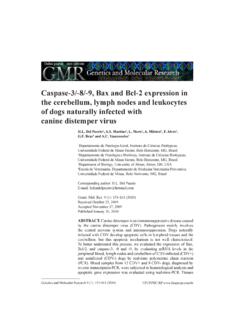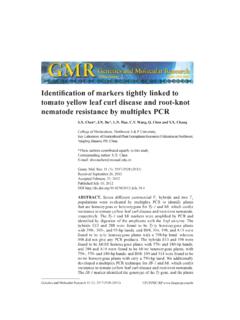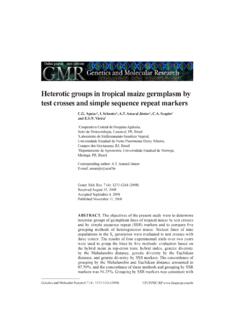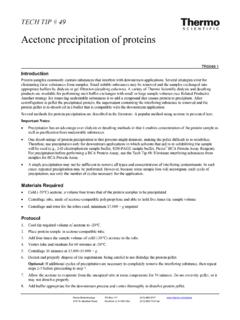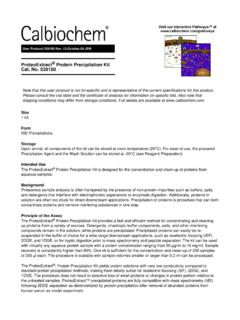Transcription of Evaluation of four protein extraction methods for ...
1 Genetics and Molecular Research 15 (3): of four protein extraction methods for proteomic analysis of mango Liao1*, Lu1*, Chen1, Y. Lu2 and Mo11 State Key Laboratory of Respiratory Disease, Guangzhou Institute of Respiratory Disease, The First Affiliated Hospital of Guangzhou Medical University, Guangzhou, China2 Chinese Academy of Tropical Agricultural Sciences Environment and Plant Protection Institute, Danzhou, China*These authors contributed equally to this author: MoE-mail: Mol. Res. 15 (3): July, 21, 2016 Accepted August 1, 2016 Published August 30, 2016 DOI 2016 The Authors.
2 This is an open-access article distributed under the terms of the Creative Commons Attribution ShareAlike (CC BY-SA) The peel of mango (Mangifera indica L.) is a special plant tissue that contains many compounds that interfere with protein extraction . A successful separation with Two-dimensional electrophoresis (2-DE) is the key step for proteomic analysis. To evaluate the efficiencies of mango peel protein extraction for 2-DE, four extraction methods were tested: 1) 2-D clean-up kit, 2) trichloroacetic acid/ acetone precipitation , 3) phenol extraction , 4) phenol with methanol/ammonium acetate precipitation .
3 The results showed that the phenol with methanol/ammonium acetate precipitation produced the best quality protein extraction and separation. Proteins were separated in 30-70 and >70 kDa ranges better than with the other methods . Acidic proteins had better resolution with fewer horizontal and vertical streaks. Liao et and Molecular Research 15 (3): proteins were identified by maxtrix-assisted laser desorption/ionisation time-of-flight tandem mass spectrometry (MALDI-TOF/TOF-MS/MS). The result demonstrated that each of these four methods can be used to prepare mango peel proteins.
4 The phenol with methanol/ammonium acetate precipitation was the best choice for proteomic analysis of mango words: Mango peel; protein extraction ; 2-DE; Proteomic analysis; EvaluationINTRODUCTIONTwo-dimensional electrophoresis (2-DE) is a powerful technique for proteome analysis. Accurate proteomic results depend on good protein separation, a critical step in 2-DE (Wang et al., 2008). Plant protein extraction is challenging because certain pigments (chlorophyll, anthocyanin), polysaccharides, phenolic compounds, and organic acids are enriched in the cell walls (Schieber et al.)
5 , 2003; Hirano et al., 2004; Ajila et al., 2007). It is necessary to remove these interfering compounds for successful protein separation before 2-DE. Several different protein extraction methods , have been applied in the study of genetic breeding (Tanaka et al., 2006), plant diseases (Al-Obaidi et al., 2014), insect repellants (Kim et al., 2008), and plant stress response (Xu et al., 2010) as so on. However, it is necessary to choose a suitable method for specific plant (Mangifera indica L.) is an important fruit in the tropics.
6 It is nutrient-rich and delicious, enjoying a reputation as the king of tropical fruits . Unfortunately, mangoes are highly perishable and difficult to store because the peels are susceptible to infection by anthracnose, resulting in severe economic losses (Lima et al., 2013). This persistent blight is likely affected by the proteins in the skin that play a major role in both biotic and abiotic stresses, such as wounding and pathogens. A proteomic study of mango peel would provide an understanding of the proteins involved, and contribute to the foundation of the improvement of mangoes, as well as the prevention and control of anthracnose disease.
7 However, mango peels are rich in ketones, polysaccharides, small molecular phenols, anthocyanins, and pectin, all of which can interfere with protein separation (Berardini et al., 2005). To date, few studies have focused on mango peel proteomics, underlining the requirement for an effective and reliable method for mango peel protein this study, four protocols were used to extract mango peel proteins. We identified the most suitable method for use in future studies by comparing the proteins separated by 2-DE. Selected spots were analyzed by mass spectrometry for AND METHODSP lant materialFresh, ripe mangoes of the disease-resistant strain Mangifera indica L.
8 Cultivarietas Tainong No. 1 were provided by the Environmental and Plant Protection Institute, Danzhou, China. Take 1 g mango peel grounding into powder in liquid of protein extraction methods for mango peelGenetics and Molecular Research 15 (3): extraction2-D clean-up kit treatmentThe powdered samples were suspended in lysis buffer (7 M urea, 2 M thiourea, 65 mM dithiothreitol (DTT), 4% 3-[(3-Cholamidopropyl) dimethylammonio]propanesulfonate (CHAPS) (w/v), 20 mM Tris, 1% ampholyte (v/v)) and vortexed for 10 min at 4 C.
9 The supernatant was collected after centrifugation at 15,000 g for 30 min at 4 C, and treated according to the 2-D clean-up kit manufacturer instruction (GE Healthcare, Sweden). The pellet was dissolved in lysis buffer and centrifuged at 15,000 g for 1 h at 4 C. The supernatant was aliquoted to new tubes and stored at -80 acid (TCA)/ acetone precipitationThe protocol was performed according to Cascardo (Cascardo et al., 2001) with some modifications. The sample was added to ice-cold acetone containing 10% TCA (w/v), b-mercaptoethanol (v/v) and homogenized on the ice.
10 After precipitation 2 h at -20 C, the mixture was centrifuged at 15,000 g for 30 min at 4 C. The supernatant was discarded, and then the pellet was rinsed three times with ice-cold extraction buffer and centrifuged at 15,000 g for 30 min at 4 C. The sample was precipitated for 2 h at -20 C between each rinse. The pellet obtained after centrifugation was treated in the same way as in 2-D clean-up kit extraction methodThe protocol was treated according to Natarajan (Natarajan et al., 2005) with some modifications. The powdered sample was suspended in extraction buffer [500 mM Tris-HCl, pH , 50 mM Ethylenediaminetetraacetic acid (EDTA), 2 mM phenylmethanesulfonyl fluoride (PMSF), 2% b-mercaptoethanol (v/v)] and homogenized at 4 C.
